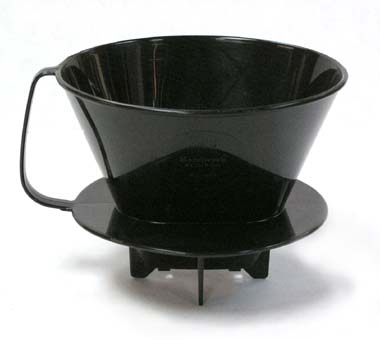I’m sorry Dagmar – my description was incomplete. You place one of those metal-mesh reusable coffee filters from yesterday inside one of these plastic coffee cone brewer thingies (pictured below). The coffee cone is designed so that it will sit securely on top of your coffee mug:

The plastic coffee cone has holes in the bottom (you can see where they are by looking at the shadow on the floor). Hot water poured into the open top first passes through the metal mesh filter, into which you have (hopefully) added fresh coffee grinds. Then the coffee (but not the coffee grinds) passes through the metal mesh, runs down the inside walls of the plastic coffee cone, and ends up inside the waiting mug below.
That is, unless you somehow forgot to place the coffee cone on the mug before you poured in the hot water, in which case you get fresh hot delicious coffee all over your kitchen counter, your sink, your stove, and probably (as I can testify from first-hand experience) your floor. 🙂
Ah, now I see, I got the work-flow wrong and I didn’t know enough about coffee cone technology. 🙂
You simply forgot the mug.
The funny thing about this is, that the kind of coffee cone we use here, doesn’t stand on it’s own. One just needs the mug to balance the cone.
So the idea of putting hot water in the cone without having it stabilised through a mug or a coffee pot before, didn’t occur to me.
But your picture explains. Yours has got a stabiliser bar.
So the question is would it make sense to use a German coffee cone without stabiliser bar to avoid the problem in the morning? 🙂
LoL – after our head of research and development did some coffee cone research, he told me that even the German ones have stabiliser bars…
I would have sworn that it would not be like this. 🙂
Thank god, I use a french press to prepare coffee – there is no cone at all….